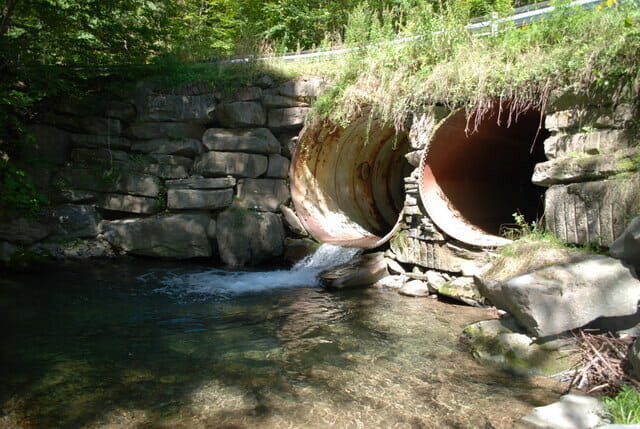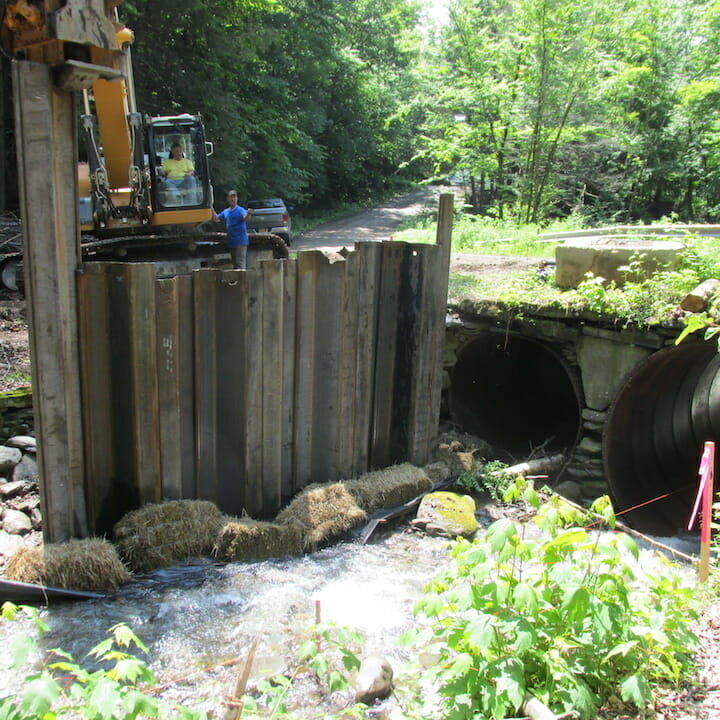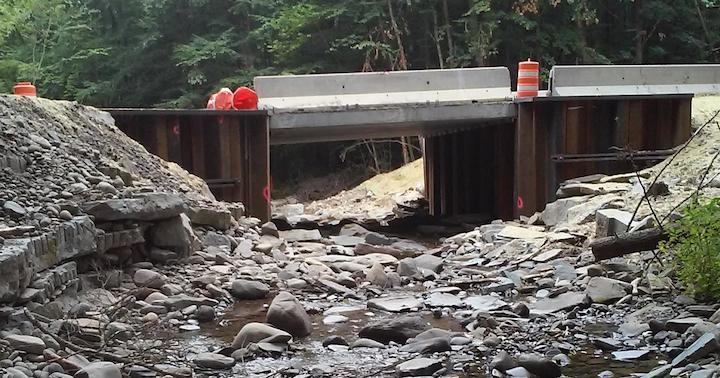The new bridge opens up 2.3 miles of high-quality habitat on this important Beaverkill tributary.
By Tracy Brown
Trout Unlimited has completed the Horse Brook Culvert Replacement Project in New York, replacing an antiquated double barrel culvert with a new single span bridge. The culverts were undersized, perched and a barrier to fish passage.
Horse Brook is a tributary to the Beaverkill near “Trout Town USA” – Roscoe, N.Y. – in the heart of the Catskills. The replacement of the culvert with a new bridge reconnects 2.3 miles of high-quality headwater habitat on a site on Town of Colchester Road.
Inadequately sized culverts can be a seasonal or year round barrier to fish, fragmenting habitat and disconnecting the natural flow of organisms, material, nutrients and energy along the river system. This loss of stream connectivity is a critical threat to valuable and already vulnerable species such as the native brook trout.
Horse Brook Downstream_TBrown Trout Unlimited.JPG

Prior to the project, two undersized culverts created an impassable barrier for fish and other aquatic organisms.
Horse Brook is a tributary to the Beaverkill and is a priority project for TU and our partners. Known as the birthplace of American fly-fishing, this area is a destination for many thousands of fisherman and women each year. Restoring and improving these waters improves fishing and is good for the local economy, which is dependent on those traveling to the area to recreate.
“The Horse Brook Project will improve trout spawning habitat on the Beaverkill,” said Bert Darrow, President of the Theodore Gordon Flyfishers. “Anglers come from all over the world to fish the Beaverkill for its wild trout and by replacing the fish barrier on Horse Brook and reconnecting critical spawning habitat, the project will help to sustain new generations of wild trout.” The Horse Brook Project has been a high priority project for TGF for many years.
Over the past few years, TU and the Town of Colchester worked closely with engineers from Woidt Engineering and Consulting and Delta Engineers, Architects, & Land Surveyors to design the project.
TU hired local contractor John Bernas with JB12 Corps to complete the on-the-ground work. Construction began in early June and finished in August 2015.
June 23 2015 Horse Brook 012[5].JPG

Construction of the project took more than two months.
The installation of the bridge included the shaping and stabilization of the stream banks, the installation of the sheet piling abutments and the installation of 10 in-stream grade control structures. The in-stream structures were designed to mimic the step pool sequence and design of the upstream reference reach. Design parameters ensure that enough variability exists in the structure to allow for passage of a diversity of aquatic species and age classes.
“With more than 8,000 members in 32 chapters across New York state, TU’s New York members have been actively working with local communities to protect and restore coldwater streams throughout New York,” said Ron Urban, chair of TU’s New York council. “The Horse Brook project will continue our efforts to improve water quality in our rivers and streams.”
Project funders include: Theodore Gordon Flyfishers, Orvis, and the Camp Fire Conservation Fund Inc., the New York City and Long Island Chapter of TU, TU NY Council Conservation Fund and the NY Fisheries Enhancement Fund. Funding was also provided by a TU Embrace-A-Stream Grant. Other important funders include New York State Environmental Protection Fund administered by the New York State Department of Environmental Conservation (NYSDEC) and the Millennium Stream Improvement Fund. The latter fund was developed as part of the initial permitting and construction of the Millennium Pipeline that runs through the southern tier of New York, and was established by Millennium Pipeline, LLC for the purpose of improving stream conditions in the areas near to the pipeline route. TU was selected as the organization to administer these fund and is working in cooperation with NYSDEC, local municipalities and organizations to develop and implement conservation projects in NY.
Tracy Brown is Trout Unlimited’s Northeastern Restoration Coordinator.



